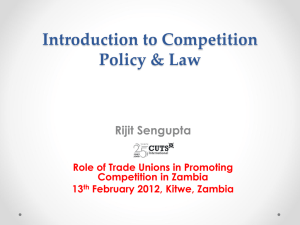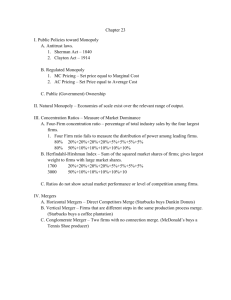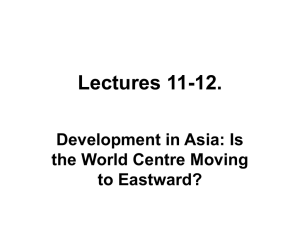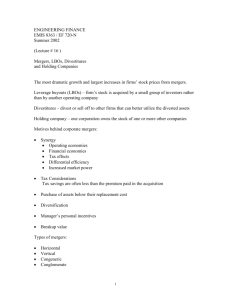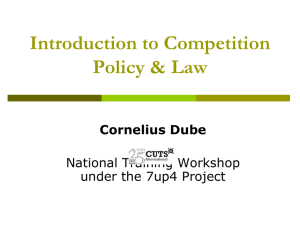Outline of Lecture 1 – Basic Economics Concepts
advertisement
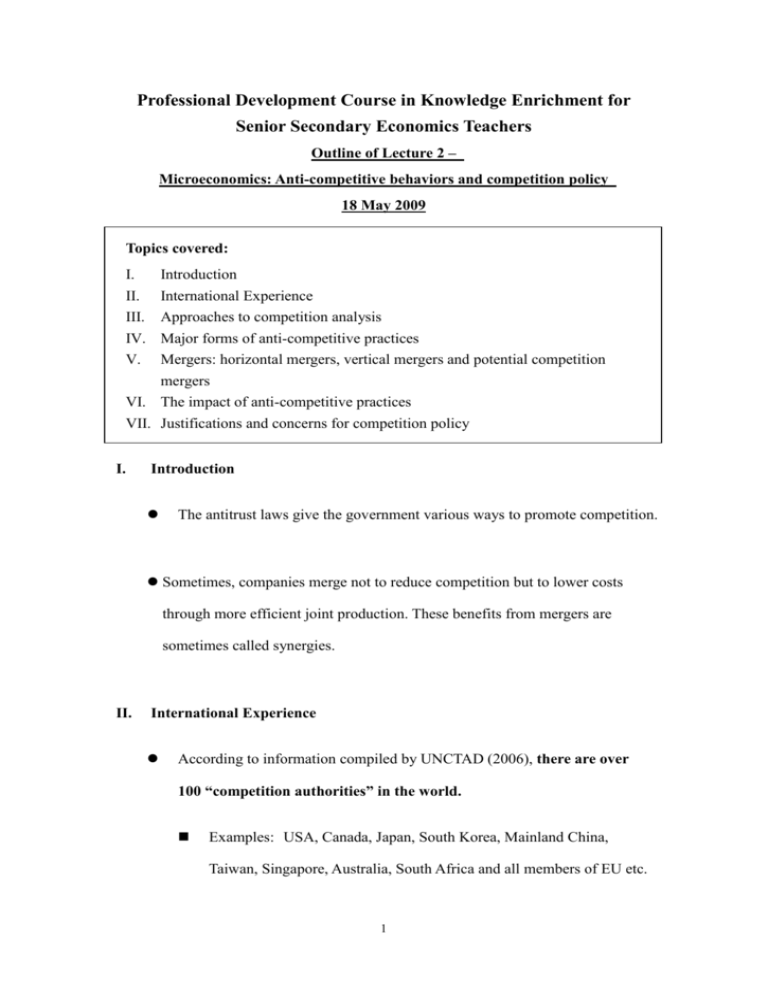
Professional Development Course in Knowledge Enrichment for Senior Secondary Economics Teachers Outline of Lecture 2 – Microeconomics: Anti-competitive behaviors and competition policy 18 May 2009 Topics covered: I. II. Introduction International Experience III. Approaches to competition analysis IV. Major forms of anti-competitive practices V. Mergers: horizontal mergers, vertical mergers and potential competition mergers VI. The impact of anti-competitive practices VII. Justifications and concerns for competition policy I. Introduction The antitrust laws give the government various ways to promote competition. Sometimes, companies merge not to reduce competition but to lower costs through more efficient joint production. These benefits from mergers are sometimes called synergies. II. International Experience According to information compiled by UNCTAD (2006), there are over 100 “competition authorities” in the world. Examples: USA, Canada, Japan, South Korea, Mainland China, Taiwan, Singapore, Australia, South Africa and all members of EU etc. 1 Coverage of competition legislation may include: Monopolies and cartels Merger and acquisition Abuse of dominant position Horizontal constraints: price fixing, bid rigging, output collusion, division of markets etc. Vertical restraints: resale price maintenance, tie-in sales, discriminatory supplies etc. Unfair trade practice: predatory pricing Exemptions: On the basis of certain public interests, some structures, conduct or performance can be exempted from the competition law, e.g. R&D cartels, networks. International tendencies Focusing on anti-competitive conduct Starting from “hard core cartels”: price fixing, bid rigging, collusive restrictions on output and division of markets (mainly horizontal restraints) (OECD, 2000) and refining legislation and enforcement over time Increasing transparency in the implementation of competition laws “Leniency” programmes to alleviate investigation and sanction problems Promoting international cooperation in dealing with multinational cartels Enhancing advocacy and education work of competition authorities 2 III. Approaches to competition analysis The basic approaches to competition policy (Boner and Krueger, 1991) encompass three key aspects: 1. Structure (結構) The focus is on market concentration, which may serve as a trigger for examination that would take into account the definition of the “relevant” market from both supply and demand sides, and determining factors such as substitutability, geographical and temporal considerations. 2. Performance (表現) The key concerns are the prices charged and outputs produced by dominant market players, and the possibilities of “abnormal profits”. 3. Conduct (行為) The attention is centred on the abuse of dominant position, horizontal and vertical restrictions and unfair trade practices. IV. Major forms of anti-competitive practices 1. Monopoly and cartels (壟斷及卡特爾) Definition of collusion: an agreement among firms in a market about quantities to produce or prices to charge. Definition of cartel: a group of firms acting in unison. 3 The Inefficiency of Monopoly Price Deadweight loss Marginal cost Monopoly price Marginal revenue 0 2. Monopoly Efficient quantity quantity Demand Quantity Abuse of dominant position (濫用支配地位) unfair or discriminatory standards among members of a trade or professional body intended to deny newcomers a chance to enter or contest in the market, and have the effect of impairing economic efficiency or free trade. Hong Kong suspected cases (疑似個案): Broadband Services (屋苑寬頻服務) Medical Services (屋苑醫療服務) Australia cases: Taxi and Retail Filling and Service Stations (的士 vs 加油站服務) 4 3. Horizontal restrictive practices (橫向限制行為) (i) Price fixing (操縱價格) An agreement between firms to fix or raise price to restrict competition and earn higher profits Colluding to fix the price is always a violation of the antitrust law. Reason: A duopoly cartel can maximize profit and behave like a monopoly. To achieve the monopoly outcome, the cartel restricts production and fixes the price at the monopoly level. The consumer suffers because consumer surplus shrinks. And the outcome is inefficient because a deadweight loss arises. Some Hong Kong suspected cases (疑似個案): Auto-Fuel Retail Market (香港燃油界) Shipping Industry (船運業) Credit Card Industry (信用咭公司) Telecommunication Industry (電訊業) The Laundry Association of Hong Kong Ltd. (洗衣業商會) Hong Kong & Kowloon Vermicelli & Noodle Manufacturing Industry Merchants' General Association (港九粉麵製造業總商會) 5 (ii) Collusive bidding/bid rigging (串通投標) (1) firms agreeing to submit common bids, thus eliminating price competition; (2) firms agreeing to submit the lowest bid by rotation and thereby each getting a certain amount of contracts Australia case: Concrete Market (混凝土市場) Hong Kong suspected cases (疑似個案): Public rental housing (PRH) metal gateset (公屋鐵閘事件) Old Building Maintenance Project(舊樓維修工程) (iii) Market division (分配市場/瓜分市場/分餅仔) allocating specific customers or sales territories to particular firms and not competing over the territory or customers of other firms Australia case: Express company (速遞公司案) Global case: Vitamin C Industry (維他命 C 案) 6 (iv) Customer allocation /joint boycotts (分配市場/瓜分市場/分餅仔) not dealing with firms that supply competitors’ products in their market Australia case: Chicken farms case (雞農案) (v) Sales and production quotas (設立銷售限制) setting quotas on the supply of certain goods or services in order to push prices up Australia case: Banana farmers case (香蕉農民案) 4. Vertical restrictive practices (縱向限制行為) (i) Resale price maintenance (RPM) (控制轉售價格) RPM occurs when a manufacturer agrees with a distributor on the price at which the product will be resold. A producer insists that any retailer selling his product must sell it at the ‘list’ price. This practice is designed to reduce competitive 7 pressures at the retail level. It is inefficient if it enables dealers to charge the monopoly price. By setting and enforcing the resale price, the manufacturer might be able to achieve the monopoly price. It is efficient if it enables a manufacturer to induce dealers to provide the efficient standard of service. (ii) Tie-in sales /tied selling (搭賣) The sale of one good on the condition that another good is purchased, in other words, a customer who buys one product must buy another. Examples Mortgage Company used to insist that those who obtained mortgages from them purchase fire insurance as well. Nintendo designs its console so that it can only be used with Nintendo games. In effect, it forces a tie-in sale between the console and the computer games. Microsoft has been accused of tying Internet Explorer and Windows. 8 (iii) Exclusive dealing (獨家交易) It is a practice by which a manufacturer does not allow a retailer to sell goods made by a competitor. V. Mergers: horizontal mergers, vertical mergers and potential competition mergers Vertical mergers – a firm merges with its suppliers. Horizontal mergers – two firms selling the same good or the same type of good merge. How does the U.S. government decide whether a merger by firms reduces competition in the market? Concentration is usually measured by the Herfindahl-Hirschman index (HHI). (nickname: Herf) HHI: the sum of the squares of the market shares of all the firms in the industry. The more concentrated the industry, the larger the shares and, therefore, the larger the HHI. The HHI is used because it indicates how likely it is that firms in the industry after the merger will have enough market power to raise prices well above marginal cost, reduce the quantity produced, and cause economic inefficiency. 9 Contestable (可競逐的) Market Ease of entry of new firms into the industry is also an important factor, as is the potential contestability of the market by other firms. Market Definition When measuring concentration in a market, the market definition is very important. Market definition is a description of the types of goods and services included in the market and the geographic area of the market. Defining the geographic area of a market is also a key aspect of defining the market for a good or service. VI. The impact of anti-competitive practices Among the above overlapping categories of anti-competitive behaviour, vertical restrictive practices are more controversial. Do vertical restraints reduce economic efficiency? Critics of competition policies often argue that they are necessary for efficiency considerations, e.g. RPM is essential for viable after-sale maintenance service; while package tie-in is beneficial to consumers etc. 10 VII. Justifications and concerns for competition policy Justifications Providing a legal basis for the investigation and sanctioning of anti-competitive conduct Strengthen institutional framework for regulating competition and for its advocacy, and hence promoting market discipline Improve the business environment and promote a level playing-field for business Improve transparency through delineating what constitutes anti-competitive conduct Without such regulatory regime, in the long term there might be an adverse effect on our relative competitiveness, especially in sectors with high entry barriers. Concerns Concerns 1: Institutional Arrangements Concerns 2 : Conduct Rules Concerns 3 : Private Action Concerns 4 : Issues of concern to SMEs Concerns 5 : Relationship with existing sector-specific laws Concerns 6 : Exemptions and exclusions 11 References 1. Mankiw, N G (2006), Principles of Economics, 4th edition, Thomson, South-Western. Chapter 15, 16 2. Taylor, John B (2004), Principles of Microeconomics, 4th edition, Houghton Mifflin. Chapter 12 3. Stiglitz, Joseph E (1997), Principles of Microeconomics, 2nd edition, Norton. Chapter 16 4. APEC Competition Policy and Law Database: http://apecweb.apeccp.org.tw/ 5. HKSAR Government Competition Policy Advisory Group website: http://www.compag.gov.hk/ 6. Professor Tsang Shu-ki’s Homepage: http://www.hkbu.edu.hk/~sktsang/ 7. Consultation Document on Competition policy http://www.edlb.gov.hk/edb/eng/papers/compete/index1.html 8. 星期日檔案 2006.10.08, 9. 星期日檔案 2006.10.15 10. Report on Public Consultation on the the detailed proposals for a competition law http://www.compag.gov.hk/reference/Consultation_Report_01.pdf 11. OECD (2006), “Hard Core Cartels: Third Report on the Implementation of the 1998 Recommendations”, OECD Report, available from the website http://www.oecd.org/dataoecd/30/2/36600303.pdf. 12. Boner, Roger Alan and Krueger, Reinald (1991) “The Basics of Antitrust Policy: A Review of Ten Nations and the European Communities”, World Bank Technical Paper no.160. 13. OECD (2000), “Hard Core Cartels”, OECD Report, available from the website http://www.oecd.org/dataoecd/36/24/2367816.pdf. 14. OECD (2006), “Hard Core Cartels: Third Report on the Implementation of the 1998 Recommendations”, OECD Report, available from the website http://www.oecd.org/dataoecd/30/2/36600303.pdf. 12
